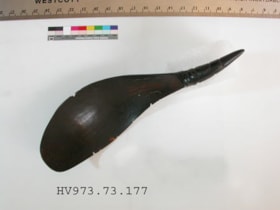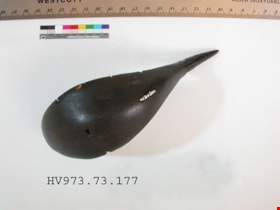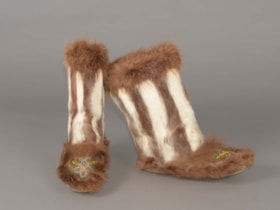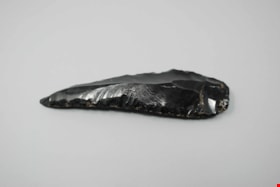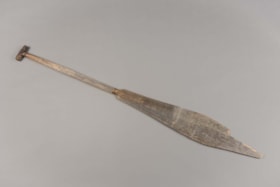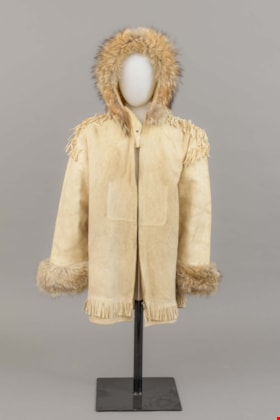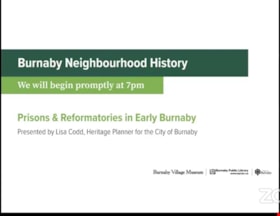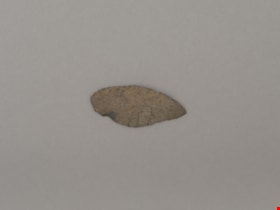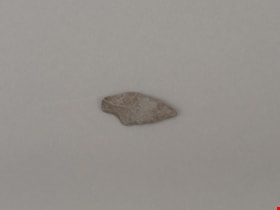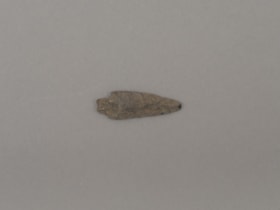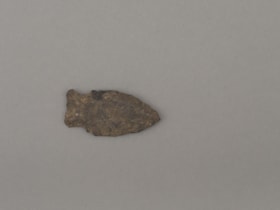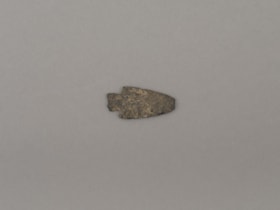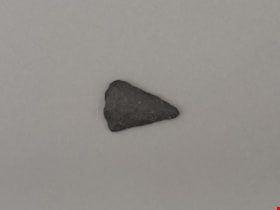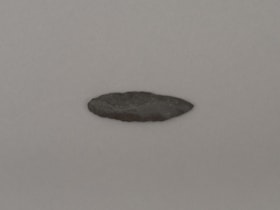Interview with Cice Brown, May 13, 2005 - Track 7
https://search.heritageburnaby.ca/link/museumdescription4482
- Repository
- Burnaby Village Museum
- Date
- 1930-1949 (interview content), interviewed May 10, 2005
- Collection/Fonds
- Burnaby Village Museum fonds
- Description Level
- Item
- Physical Description
- 1 sound recording (mp3) (0:03:14 min)
- Scope and Content
- Track 7: This portion of the recording pertains to changes to Burnaby since Cice’s childhood. Cice discusses the rural nature of South Burnaby, and the sense of security of that time. She talks of the changes caused by the creation and growth of the Metrotown area. Cice describes how her husband’s …
- Repository
- Burnaby Village Museum
- Collection/Fonds
- Burnaby Village Museum fonds
- Series
- Museum Oral Histories series
- Subseries
- Growing Up in Burnaby subseries
- Description Level
- Item
- Physical Description
- 1 sound recording (mp3) (0:03:14 min)
- Material Details
- Interviewer: Tom Gooden Interviewee: Cice Brown Date of Interview: May 13, 2005 Total Number of Tracks: 7 Total length of all Tracks: 0:40:19
- Scope and Content
- Track 7: This portion of the recording pertains to changes to Burnaby since Cice’s childhood. Cice discusses the rural nature of South Burnaby, and the sense of security of that time. She talks of the changes caused by the creation and growth of the Metrotown area. Cice describes how her husband’s veteran status earned them a discount on a building lot from the City of Burnaby, allowing her to continue to live there.
- History
- Recording of an interview with Cice Brown, interviewed by Tom Gooden on May 13 2005. This recording was completed for an exhibit, Growing Up in Burnaby, for the Burnaby Village Museum. Major themes discussed are growing up in Burnaby in the 1930s and 40s.
- Creator
- Burnaby Village Museum
- Names
- Brown, Cice Chandler
- Accession Code
- BV017.45.3
- Access Restriction
- No restrictions
- Reproduction Restriction
- May be restricted by third party rights
- Date
- 1930-1949 (interview content), interviewed May 10, 2005
- Media Type
- Sound Recording
- Planning Study Area
- Maywood Area
Audio Tracks
Interview with Cice Brown, May 13, 2005 - Track 7, 1930-1949 (interview content), interviewed May 10, 2005
Interview with Cice Brown, May 13, 2005 - Track 7, 1930-1949 (interview content), interviewed May 10, 2005
https://search.heritageburnaby.ca/media/hpo/_Data/_BVM_Sound_Recordings/Oral_Histories/2017_0045_0003_007.mp3Interview with Prem Kaur Gill, Santokh Singh Gill and Mohinder Kaur Gill
https://search.heritageburnaby.ca/link/museumdescription19347
- Repository
- Burnaby Village Museum
- Date
- [1957-2022] (interview content), interviewed 11 Nov. 2022
- Collection/Fonds
- Burnaby Village Museum fonds
- Description Level
- Item
- Physical Description
- 1 sound recording (m4a) (118 min., 39 sec.) + 1 sound recording (mp3) (115 min., 20 sec.)
- Scope and Content
- Item consists of an oral history interview with Santokh "Gurmail" Singh Gill and Mohinder Kaur Gill and their daughter, Prem Kaur Gill conducted by interviewers, Anushay Malik and Rajdeep. The interview is conducted in English, Punjabi, Hindi and Urdu. The three members of the Gill family share the…
- Repository
- Burnaby Village Museum
- Collection/Fonds
- Burnaby Village Museum fonds
- Series
- Museum Oral Histories series
- Description Level
- Item
- Physical Description
- 1 sound recording (m4a) (118 min., 39 sec.) + 1 sound recording (mp3) (115 min., 20 sec.)
- Material Details
- Interviewers: Anushay Malik, Rajdeep Interviewees: Prem Kaur Gill, Santokh "Gurmail" Singh Gill and Mohinder Kaur Gill Location of Interview: Gill family residence on Warwick Avenue in Burnaby Interview Date: November 11, 2022 Total Number of tracks: 1 Total Length of all Tracks: (1:58:39) Digital master recording (m4a) was converted to mp3 for access on Heritage Burnaby
- Scope and Content
- Item consists of an oral history interview with Santokh "Gurmail" Singh Gill and Mohinder Kaur Gill and their daughter, Prem Kaur Gill conducted by interviewers, Anushay Malik and Rajdeep. The interview is conducted in English, Punjabi, Hindi and Urdu. The three members of the Gill family share their ancestral background, their personal experiences immigrating to Canada, living in Burnaby and working in British Columbia as South Asian immigrants. 00:00 – 27:34 Santokh “Gurmail” Singh Gill and Mohinder Kaur Gill share their migration stories and experiences living and working in British Columbia as South Asian immigrants and their eldest child, Prem Kaur Gill shares her own experiences as a child of South Asian immigrants and growing up in British Columbia as a South Asian Canadian. Gurmail Singh Gill was born in the District of Jalandhar and Mohinder Kaur Gill was born in Hoshiapur of the Indian state of Punjab. Gurmail describes how he moved from India to England with his family in 1957, immigrated to Canada from England in 1966, married his wife Mohinder in England in 1968 and brought his family (parents and two siblings) to Canada from England in 1970 and other relatives including his wife’s family in the 1970s and 1980s. Mohinder and Gurmail Gill recollect their arranged marriage in England in 1968, their immigration process and explain how they arrived in Burnaby residing with a cousin at 4649 Georgia Street until they were able to purchase their own home after a few years. Gurmail shares names and connections to the relatives that came to British Columbia before him. Gurmail and Mohinder tell how they lived in the basement of the house and rented out the upper floor to save money. The couple recall what they brought with them when they immigrated to Canada and Mohinder Kaur Gill tells of how before leaving India, she and her mother made a special rajai for her to take with her. Mohinder describes the process of making a rajai (a quilted blanket that was made by hand). Gurmail and Mohinder Gill talk about the challenges that they’ve experienced as new immigrants including not being fluent in English, the cold weather and not having very many family or friends nearby to provide support. They attended the Gurdwara on Ross Street or Akali Singh Sikh Society Gurdwara on Skeena in Vancouver. They explain how there was limited access to grocery stores that supplied Punjabi and Indian spices and other cooking supplies. They talk about how they used a food mill and mortar and pestle to grind their own spices and flour and how Mohinder often made traditional sweets like barfi and laddo and pakoras using pea flour when they couldn’t get Besan flour. 27:35 – 36:11 Gurmail provides more details on his family’s immigration story, including names of relatives, how his six siblings and parents all immigrated to British Columbia in 1970 and how in the early 1970s and mid 1980’s Gurmail and his family sponsored approximately 70 friends and relations from India (including Mohinder’s family) to immigrate to Canada. When Mohinder’s family arrived they lived with them in their house until they were able to purchase property next door and build their own home. Children in the families all attended elementary and high school in Burnaby which now amounts to three generations. 36:12 – 59:28 Gurmail and Mohinder Gill talk about their experiences of racial discrimination. Gurmail recalls members of the South Asian community, Dr. Hari Prakash Sharma, Harinder Mahil and Charan Gill starting the British Columbia Organization to Fight Racism. Gurmail tells of how he got involved contributing some of his union dues as a member of CAIMAW (Canadian Association of Industrial Mechanical and Allied Workers Union- Local 15) and as a friend of Charan Gill and Raj Chouhan of the Canadian Farm Workers Union. Gurmail Gill explains how he was a founding member of CAIMAW and treasurer until the union merged with the Canadian Auto Workers Union (in 1991). Mohinder and Gurmail tell of how people from the South Asian community were discouraged from wearing Punjabi dresses or head coverings for fear of being yelled at with racial slurs and how it was often scary to go outside. Many from their community often avoided attending the Akali Singh Gurdwara since a head covering was required and people were afraid of being a target. Gurmail provides details about his work with A1 Steel, how different unions were formed pertaining to various skillsets and jobs per company and how he became a member of CAIMAW Local 15 (foundry workers). Mohinder recollects her experiences as a mother, the daily tasks involved and friends that she made who’d also emigrated from Punjab. Mohinder describes how she designed and sewed many Punjabi dresses using her electric sewing machine and how she learned English by attending adult classes at a church on Commercial Drive. Mohinder and her mother attended the classes for two hours per day for six years at a cost of twelve dollars for ten weeks. Once Mohinder could speak a little English, she started working and was able to practice more. 59:29 – 1:06:08 Mohinder, Gurmail and Prem talk about some of their favourite traditional foods including corn roti and spinach curry and how they grow many of their own vegetables including peppers, eggplant, saag (spinach), onions, garlic, cilantro, zucchini, squash and fenugreek. Mohinder reflects on how access to Punjabi clothing and fabric stores in Vancouver has changed and that ready made food is now more available. Traditional foods were previously made from scratch with women gathering together and cooking for hours and now it’s gotten easier but more expensive and less of a community feel. 1:06:09- 1:55:20 Mohinder and Gurmail Gill discuss and share their perspectives and experiences on raising a family in the past versus today. Gurmail imparts that all of his siblings became educated and secured professional careers while he continued to work in the trades. Prem Kaur Gill shares her own experiences growing up and attending school in Burnaby. Gurmail and Mohinder Gill recall the type of suitcase that they brought with them when they immigrated and how they recently they got rid of it. Gurmail and the group reflect and discuss the confusion with racial identity terms that have been used in this country. They comment that South Asians were referred to as “Hindu” and “East Indian” and Indigenous peoples were referred to as “Indian” and the controversy and racism behind some of these terms. The group discusses the impact of the caste system and other discriminatory experiences and compare their experiences of living in England to living in Canada. Prem comments on how it’s just recently that South Asian customs, celebrations and practices have been recognized and celebrated here in Canada, like Diwali and yoga. They comment on how much of the language, culture and customs have been retained in Surrey where many can still communicate in Punjabi and don’t need to be fluent in English. The group discusses how many South Asians immigrants first lived and worked in Vancouver but with rising property prices many moved to Surrey expanding and establishing a much larger South Asian community with resources. The group discusses and compares the differing travel routes that many of them and their relatives took when immigrating and travelling between India and Canada. The group talks about Rajdeep’s ancestral village in India which is near the Gill village of Firozpur. Gurmail explains the origins and details behind his family name that was changed from “Shergill” to “Gill” and the name “Santokh” from his maternal side.
- History
- Interviewees' biographies: Santokh "Gurmail" Singh Gill was born in the District of Jalandhar in Punjab, India. Gurmail moved to England with his family in 1957 and immigrated to British Columbia in 1966. Gurmail married his wife, Mohinder Kaur Gill in England in 1968 and she immigrated to British Columbia from England soon after. Gurmail first lived with a cousin in Burnaby before purchasing a home of his own in Burnaby where he raised his family. Gurmail worked in the steel industry and was a member and treasurer of the CAIMAW before the union merged with the Canadian Auto Workers Union. Mohinder Kaur Gill was born in the Hoshiapur in Punjab, India. She married her husband Santokh "Gurmail" Singh Gill in England in 1968 and immigrated to Burnaby, British Columbia to join her husband. Mohinder and Gurmail Gill have four children, all born in Burnaby. Prem Kaur Gill was born in Burnaby in 1969 and is the eldest child of Santokh "Gurmail" Singh Gill and Mohinder Kaur Gill. Prem grew up and attended school in Burnaby. Interviewers' biographies: Anushay Malik is labor historian with a geographical focus on South Asia. Anushay studied at the University of London and was a research fellow at the International Institute of Social History in Amsterdam, Netherlands. In 2014, Anushay moved back to her native Pakistan and joined Lahore University of Management Services as an Assistant Professor. In 2023, Anushay is a visiting scholar at Simon Fraser University and lives in Burnaby with her family. Anushay was a co-curator of the Burnaby Village Museum exhibit “Truths Not Often Told: Being South Asian in Burnaby”. Rajdeep was born and raised in the Lower Mainland and is of Punjabi (South Asian) descent. She has an Associate of Arts degree in Asian Studies from Kwantlen Polytechnic University, a Bachelor of Arts (Hons.) in Anthropology from the University of British Columbia. She is a student in the Restoration of Natural Systems program at the University of Victoria. Rajdeep works at Simon Fraser University as a Program Assistant and as a researcher with the City of Burnaby. At Burnaby Village Museum, Rajdeep contributed to the exhibit “Truths Not Often Told: Being South Asian in Burnaby”.
- Creator
- Burnaby Village Museum
- Subjects
- Clothing
- Foods
- Indigenous peoples
- Buildings - Religious - Temples
- Food Processing Tools and Equipment
- Persons - South Asian Canadians
- Social Issues
- Social Issues - Racism
- Migration
- Occupations
- Organizations - Unions
- Responsibility
- Rajdeep
- Malik, Anushay
- Accession Code
- BV022.29.2
- Access Restriction
- No restrictions
- Reproduction Restriction
- No known restrictions
- Date
- [1957-2022] (interview content), interviewed 11 Nov. 2022
- Media Type
- Sound Recording
- Notes
- Title based on contents of item
- Transcript available upon request - contact Burnaby Village Museum
- Indian Family System Reference notes: Baba = informal way to say grandfather; old man Bibi = informal way to say grandmother; old woman Dada= paternal grandfather Dadi= paternal grandmother Dadke= paternal family members; paternal side (Various spellings might exist for the following terms) Thaiyya= father’s elder brother (uncle) Thaiyyi= father’s elder brother’s wife (aunt) Chacha= father’s younger brother (uncle) Chachi= father’s younger brother’s wife (aunt) Bua= father’s sister (older or younger) (aunt) Phuphar= father’s sister’s husband (uncle) Nana= maternal grandfather Nani= maternal grandmother Nanke/nanka= maternal family members; maternal side Mama= mom’s brother (older or younger) (uncle) Mami= mom’s brother’s wife (aunt) Maasi= mom’s sister (older or younger) (aunt) Maasard= mom’s sister’s husband (uncle)
Audio Tracks
Interview with Prem Kaur Gill, Santokh Singh Gill and Mohinder Kaur Gill, [1957-2022] (interview content), interviewed 11 Nov. 2022
Interview with Prem Kaur Gill, Santokh Singh Gill and Mohinder Kaur Gill, [1957-2022] (interview content), interviewed 11 Nov. 2022
https://search.heritageburnaby.ca/media/hpo/_Data/_BVM_Sound_Recordings/Oral_Histories/2022_0029_0002_002.mp3Jimmy Chow on set of "Legends of the Fall"
https://search.heritageburnaby.ca/link/museumdescription19204
- Repository
- Burnaby Village Museum
- Date
- [1993]
- Collection/Fonds
- Hipman "Jimmy" Chow and Donna Polos fonds
- Description Level
- Item
- Physical Description
- 1 photograph : col. ; 15 x 10 cm
- Scope and Content
- Photograph of Jimmy Chow on the set during the filming of "Legends of the Fall" on location in Alberta. Jimmy worked as property master on this film. Jimmy is standing on a hill in front of a string of horses ridden by Indigenous actors (portraying Native Americans in Montana) holding bows and arr…
- Repository
- Burnaby Village Museum
- Collection/Fonds
- Hipman "Jimmy" Chow and Donna Polos fonds
- Description Level
- Item
- Physical Description
- 1 photograph : col. ; 15 x 10 cm
- Scope and Content
- Photograph of Jimmy Chow on the set during the filming of "Legends of the Fall" on location in Alberta. Jimmy worked as property master on this film. Jimmy is standing on a hill in front of a string of horses ridden by Indigenous actors (portraying Native Americans in Montana) holding bows and arrows and dressed in stereotypical native costumes. The film was directed by Edward Zwick and was released in 1994.
- Subjects
- Industries - Film
- Indigenous peoples - North America
- Animals - Horses
- Occupations - Actors
- Persons - Chinese Canadians
- Names
- Chow, Hipman "Jimmy"
- Accession Code
- BV022.21.48
- Access Restriction
- No restrictions
- Reproduction Restriction
- May be restricted by third party rights
- Date
- [1993]
- Media Type
- Photograph
- Scan Resolution
- 600
- Scan Date
- 2023-03-06
- Notes
- Title based on contents of photograph
- Hipman "Jimmy" Chow also used the name "James H. Chow" as a propety master in the film industry and was often credited by this name
Images
Jimmy Chow on set of "Legends of the Fall"
https://search.heritageburnaby.ca/link/museumdescription19247
- Repository
- Burnaby Village Museum
- Date
- [1993]
- Collection/Fonds
- Hipman "Jimmy" Chow and Donna Polos fonds
- Description Level
- Item
- Physical Description
- 1 photograph : col. ; 10 x 15 cm
- Scope and Content
- Photograph of Jimmy Chow on the set during the filming of "Legends of the Fall" on location in Alberta. Jimmy worked as property master on this film. Jimmy is standing on a hill with a string of horses ridden by Indigenous actors (portraying Native Americans in Montana) lined up on a ridge behind …
- Repository
- Burnaby Village Museum
- Collection/Fonds
- Hipman "Jimmy" Chow and Donna Polos fonds
- Description Level
- Item
- Physical Description
- 1 photograph : col. ; 10 x 15 cm
- Scope and Content
- Photograph of Jimmy Chow on the set during the filming of "Legends of the Fall" on location in Alberta. Jimmy worked as property master on this film. Jimmy is standing on a hill with a string of horses ridden by Indigenous actors (portraying Native Americans in Montana) lined up on a ridge behind him. The film was directed by Edward Zwick and was released in 1994.
- Subjects
- Industries - Film
- Indigenous peoples - North America
- Animals - Horses
- Occupations - Actors
- Persons - Chinese Canadians
- Names
- Chow, Hipman "Jimmy"
- Accession Code
- BV022.21.92
- Access Restriction
- No restrictions
- Reproduction Restriction
- May be restricted by third party rights
- Date
- [1993]
- Media Type
- Photograph
- Scan Resolution
- 600
- Scan Date
- 2023-03-07
- Notes
- Title based on contents of photograph
- Hipman "Jimmy" Chow also used the name "James H. Chow" as a propety master in the film industry and was often credited by this name
Images
The Legend of Deer Lake and Indigenous histories of Burnaby
https://search.heritageburnaby.ca/link/museumdescription15666
- Repository
- Burnaby Village Museum
- Date
- 4 May 2021
- Collection/Fonds
- Burnaby Village Museum fonds
- Description Level
- Item
- Physical Description
- 1 video recording (mp4) (62 min., 28 sec.) : digital, col., sd., stereo ; 29 fps
- Scope and Content
- Item consists of a video recording of a live Zoom webinar hosted by Adrian Avendaño, Stewardship Program Manager with Still Moon Arts Society. The webinar is presented in partnership with the Burnaby Village Museum, Burnaby Public Library and Still Moon Arts Society. The webinar is titled "The Lege…
- Repository
- Burnaby Village Museum
- Collection/Fonds
- Burnaby Village Museum fonds
- Description Level
- Item
- Physical Description
- 1 video recording (mp4) (62 min., 28 sec.) : digital, col., sd., stereo ; 29 fps
- Material Details
- Presenter: John Preissl
- Host: Adrian Avendano (Still Moon Arts Society)
- Date of Presentation: Tuesday, May 4, 7:00 pm - 8:00 pm
- Total Number of tracks: 1
- Total Length of all tracks: 62 min., 28 sec.
- Recording Device: Zoom video communication platform
- Recording Note: Film was edited from it's original recorded version (77 min., 48 sec.) to edited version (62 min., 28 sec.) for public viewing on Heritage Burnaby.
- Scope and Content
- Item consists of a video recording of a live Zoom webinar hosted by Adrian Avendaño, Stewardship Program Manager with Still Moon Arts Society. The webinar is presented in partnership with the Burnaby Village Museum, Burnaby Public Library and Still Moon Arts Society. The webinar is titled "The Legend of Deer Lake and Indigenous histories of Burnaby" and is presented by John Preissl, Freelance Photographer of Sḵwx̱wú7mesh and Leq’á:mel Nation ancestry. The Zoom webinar is the third in a series of six "Neighbourhood Speaker series" webinars exploring a range of topics shared by Indigenous speakers and knowledge keepers that were presented and made available to the public between April 27 and May 12, 2021. The live webinar was also made available on the Burnaby Village Museum's facebook page. Community members were invited to participate by bringing questions during the interactive online sessions. This webinar was made available in In partnership with Still Moon Arts Society. In this webinar, John Preissl shares his family’s long history from the first Chief Capilano in the late 1700's to the present day. Looking through the lens of his camera, John weaves together stories of the Legend of Deer Lake, resource gathering in the Burnaby Lake Watershed, and protection of the sacred salmon and eagle habitat on the shared homelands of the hən̓q̓əmin̓əm and Sḵwx̱wú7mesh speaking peoples. The presentation is supported with photographs that John has taken over the years documenting the diverse environment and wildlife habitats in Burnaby, the lower mainland and west coast including waterways and the fight to protect it. Following the presentation, John Preissl takes questions from the audience that are moderated by the host, Adrian Avendaño.
- History
- John Preissl is a Burnaby-based environmental, adventure, wildlife and Indigenous freelance photographer. He is a media expert with over two decades of media experience and consulting. John is of Sḵwx̱wú7mesh and Leq’á:mel Nation ancestry. His Great times-two Grandfather was the Great Chief Joe Capilano. John leads many First Nations Tours in Burnaby from Deer Lake, Burnaby Lake, Burnaby Mountain and pretty well all over Sḵwx̱wú7mesh and Tsleil-Waututh Nations Lands.
- Subjects
- Indigenous peoples - British Columbia - Social life and customs
- Animals - Birds
- Animals - Fish
- Geographic Features - Lakes and Ponds
- Geographic Features - Ravines
- Names
- Preissl, John
- Tsleil-Waututh Nation
- Sḵwx̱wú7mesh Nation
- Avendaño, Adrian
- Burnaby Village Museum
- Accession Code
- BV021.17.3
- Access Restriction
- No restrictions
- Reproduction Restriction
- No known restrictions
- Date
- 4 May 2021
- Media Type
- Moving Images
- Historic Neighbourhood
- Burnaby Lake (Historic Neighbourhood)
- Planning Study Area
- Burnaby Lake Area
- Notes
- Title based on content of video recording The following links were shared at the end of the presentation:
- The Legend of Deer Lake: https://www.legendsofvancouver.net/deer-lake-burnaby-vancouver
- Saving the Salmon: the Brunette River Story, a short film about the preservation of Brunette River: https://search.heritageburnaby.ca/permalink/museumvideo4486
- Saving Burnaby Lake, a short film about the preservation of Burnaby Lake: https://search.heritageburnaby.ca/permalink/museumvideo4485
- Still Creek Streamkeepers: https://stillmoonarts.ca/stewardship/streamkeepers/
- John Preissl’s photography website: https://johnpreisslphotography.ca/
Images
Video
The Legend of Deer Lake and Indigenous histories of Burnaby, 4 May 2021
The Legend of Deer Lake and Indigenous histories of Burnaby, 4 May 2021
https://search.heritageburnaby.ca/media/hpo/_Data/_BVM_Moving_Images/2021_0017_0003_002.mp4Mary Stanley and two women with totem pole
https://search.heritageburnaby.ca/link/museumdescription20247
- Repository
- Burnaby Village Museum
- Date
- [195-]
- Collection/Fonds
- Esther Love Stanley fonds
- Description Level
- Item
- Physical Description
- 1 photograph : b&w ; 9 x 9.5 cm
- Scope and Content
- Photograph of Mary (Stanley) Pearson (left) standing with two women on wooden platform in front of a totem pole.
- Repository
- Burnaby Village Museum
- Collection/Fonds
- Esther Love Stanley fonds
- Description Level
- Item
- Physical Description
- 1 photograph : b&w ; 9 x 9.5 cm
- Scope and Content
- Photograph of Mary (Stanley) Pearson (left) standing with two women on wooden platform in front of a totem pole.
- Accession Code
- BV022.32.669
- Access Restriction
- No restrictions
- Reproduction Restriction
- No known restrictions
- Date
- [195-]
- Media Type
- Photograph
- Scan Resolution
- 600
- Scan Date
- 2023-08-29
- Notes
- Title based on contents of photograph
- Photograph is part of Esther Love Stanley photograph album 2 (BV032.22.431)
- Note in black ink on verso of photograph reads: "MARY"
- Note in white ink on album page reads: "MARY"
Images
Mountain Goat Horn Spoon
https://search.heritageburnaby.ca/link/museumartifact30018
- Repository
- Burnaby Village Museum
- Accession Code
- HV973.73.177
- Description
- Horn spoon with fine carving on the narrow handle. Material is very dark.
- Object History
- Along the Northwest Coast, in general, undecorated spoons of wood and horn were used in everyday life, while more elaborately carved versions were used on special occasions. Horn spoons were often passed down in families as heirlooms, such spoons are generally darker in colour than those of recent manufacture. The bowls of these spoons are too large to place in the mouth, so food is sipped from the sides or the end.
- The bowl of the mountain goat horn spoon is made from the larger part of the horn, at the base. The handle is made from the tip. It is straightened out by steaming in a wooden mould and then scored out inside as part of the shaping process
- Country Made
- Canada
- Province Made
- British Columbia
- School/Style
- Coast Salish
- Culture
- Haida
Images
Documents
mukluks
https://search.heritageburnaby.ca/link/museumartifact84434
- Repository
- Burnaby Village Museum
- Accession Code
- BV008.54.2
- Description
- Pair of mukluks made out of a combination of muskrat, caribou, seal, and moose hide. The musktrat fur goes up the calf of the muklucks. There is bead work on the upper foot and toe area, using yellow, green, blue, red, pink and black beads to make a floral design.
- Object History
- Parka was purchased by donor's wife in either Altin BC or near Perry River, Yukon between 1936 and 1943.
- Country Made
- Canada
- Province Made
- British Columbia
- Site/City Made
- Atlin
Images
Documents
Neighbourhood Speaker Series - Spring 2021 subseries
https://search.heritageburnaby.ca/link/museumdescription15663
- Repository
- Burnaby Village Museum
- Date
- 2021
- Collection/Fonds
- Burnaby Village Museum fonds
- Description Level
- Subseries
- Physical Description
- 6 video recordings (mp4)
- Scope and Content
- Subseries consists of six webinars created in the Spring of 2021 that were presented on Zoom and the Burnaby Village Museum’s facebook page between April 27 and May 12, 2021. The webinars are hosted by Burnaby Village Museum in partnership with Burnaby Public Library. Burnaby Village Museum curator…
- Repository
- Burnaby Village Museum
- Collection/Fonds
- Burnaby Village Museum fonds
- Description Level
- Subseries
- Physical Description
- 6 video recordings (mp4)
- Scope and Content
- Subseries consists of six webinars created in the Spring of 2021 that were presented on Zoom and the Burnaby Village Museum’s facebook page between April 27 and May 12, 2021. The webinars are hosted by Burnaby Village Museum in partnership with Burnaby Public Library. Burnaby Village Museum curator, Jane Lemke; assistant curator, Kate Petrusa and Adrian Avendaño, Stewardship Program Manager with Still Moon Arts Society acted as hosts for the webinars. The series explores a range of topics shared by Indigenous speakers and knowledge keepers. Community members were invited to participate by bringing questions during the interactive online sessions. Webinars: 1) Bringing Visibility to the Land: A Tsleil-Waututh Perspective on Community Building presented by Michelle George 2) Traditional, Ancestral & Unceded: A Conversation on Territorial Acknowledgement presented by Fancy Poitras and Rebekah Mahaffey 3) The Legend of Deer Lake and Indigenous Histories of Burnaby presented by John Preissl 4) Creating Visibility in Wood Working presented by Xwalacktun 5) Weaving and Learning Through Art presented by Nicole Preissl 6) Are We Really Changing? Reflections on Reconciliation presented by Brandon Gabriel
- Accession Code
- BV021.17
- Access Restriction
- No restrictions
- Reproduction Restriction
- No known restrictions
- Date
- 2021
- Media Type
- Moving Images
- Notes
- Title based on contents of subseries
- Item level descriptions of webinars will be processed as they become available
obsidian knife
https://search.heritageburnaby.ca/link/museumartifact44869
- Repository
- Burnaby Village Museum
- Accession Code
- BV002.57.20
- Description
- Butchering knife, obsidian; sharpened edges.
- Object History
- The donor inherited this artifact from his mother, Katherine Maude (Kitty) Peers, who inherited them from her father, Louis Claude Hill. The artifacts were found on his farm, Brookfield Farm, at Douglas Road and Sperling Avenue (now site of Burnaby Village Museum).
- Historic Neighbourhood
- Burnaby Lake (Historic Neighbourhood)
Images
Documents
paddle
https://search.heritageburnaby.ca/link/museumartifact16839
- Repository
- Burnaby Village Museum
- Accession Code
- HV980.2.131
- Description
- Men’s paddle carved from cedar wood. The shaft is flattened with a "T" style grip mortised at top The blade is flat with one side of the tip missing. There are other cracks in the blade.
- Object History
- Style of blade indicates it is a man’s paddle, for everyday use (see Barnett 1955:116). Anthropologist Homer Barnett notes: “Paddles were made of yellow cedar, yew, and maple. Those of maple and cedar were painted, the man’s being black and the woman’s red. A smoky pitch fire and oil gave an impenetrable black (116). Men’s paddles had a crutch or crosspiece handle – either one piece or doweled on. There were different shapes of paddles for women, steering, sealing and night hunting.
- Marks/Labels
- "Yale" written on tag.
- Country Made
- Canada
- Province Made
- British Columbia
- Site/City Made
- Yale
- School/Style
- Coast Salish
Images
Documents
parka
https://search.heritageburnaby.ca/link/museumartifact84433
- Repository
- Burnaby Village Museum
- Accession Code
- BV008.54.1
- Description
- Possible caribou hide parka with fur trimmed hood and cuffs. There are tassels along the shoulders and bottom hem. There is a zipper closure at the front.
- Object History
- Parka was purchased by donor's wife in either Altin BC or near Perry River, Yukon between 1936 and 1943.
- Country Made
- Canada
- Province Made
- British Columbia
- Site/City Made
- Atlin
Images
Documents
Prisons & Reformatories in Early Burnaby
https://search.heritageburnaby.ca/link/museumdescription14759
- Repository
- Burnaby Village Museum
- Date
- 15 Oct. 2020
- Collection/Fonds
- Burnaby Village Museum fonds
- Description Level
- Item
- Physical Description
- 1 video recording (mp4) (60 min., 53 sec.) : digital, col., sd., stereo ; 29 fps
- Scope and Content
- Item consists of a video recording of a live Zoom webinar hosted by Burnaby Village Museum's Kate Petrusa. The webinar is titled "Prisons & Reformatories in Early Burnaby" and is presented by Lisa Codd, Heritage Planner for the City of Burnaby. The zoom webinar is the fourth in a collection of seve…
- Repository
- Burnaby Village Museum
- Collection/Fonds
- Burnaby Village Museum fonds
- Description Level
- Item
- Physical Description
- 1 video recording (mp4) (60 min., 53 sec.) : digital, col., sd., stereo ; 29 fps
- Material Details
- Presenter: Lisa Codd
- Host: Kate Petrusa
- Date of Presentation: October 15, 6:00 pm - 8:00 pm
- Total Number of tracks: 1
- Total Length of all tracks:60 min., 53 sec
- Recording Device: Zoom video communication platform
- Scope and Content
- Item consists of a video recording of a live Zoom webinar hosted by Burnaby Village Museum's Kate Petrusa. The webinar is titled "Prisons & Reformatories in Early Burnaby" and is presented by Lisa Codd, Heritage Planner for the City of Burnaby. The zoom webinar is the fourth in a collection of seven "Burnaby Neighbourhood Speaker series" webinars that were presented and made available to the public between September 29 and October 27, 2020. The live webinar and recording was also made available on the Burnaby Village Museum's facebook page. In this webinar, Lisa Codd talks about how in the early 20th century Burnaby was home to several correctional and detention institutions that sought to reform their residents, including the Oakalla Prison Farm, New Haven Borstal Home for Boys and Youthful Offenders, the United Church Home for Girls and Home of the Friendless. Lisa supports her presentation with contemporary and historical photographs and research. Lisa pauses throughout the presentation to take questions from webinar participants.
- Creator
- Burnaby Village Museum
- Subjects
- Persons - Japanese Canadians
- Indigenous peoples - British Columbia
- Public Services - Correctional
- Names
- Codd, Lisa
- Oakalla Prison Farm
- New Haven Correctional Centre
- Lower Mainland Regional Correctional Centre
- George, Richardson
- George, Eneas
- George, Alex
- George, Joseph
- Peltier, Leonard
- Home of the Friendless
- Responsibility
- Petrusa, Kate
- Geographic Access
- Oakmount Crescent
- Street Address
- 5220 Oakmount Crescent
- 4250 Marine Drive
- Accession Code
- BV020.29.4
- Access Restriction
- No restrictions
- Reproduction Restriction
- No known restrictions
- Date
- 15 Oct. 2020
- Media Type
- Moving Images
- Historic Neighbourhood
- Burnaby Lake (Historic Neighbourhood)
- Fraser Arm (Historic Neighbourhood)
- Planning Study Area
- Oakalla Area
- Suncrest Area
- Notes
- Title based on contents of video recording
- Video recording was edited for publication on Heritage Burnaby. Original mp4 video recording (BV020.29.4.1) is 73 min.
Images
Video
Prisons & Reformatories in Early Burnaby, 15 Oct. 2020
Prisons & Reformatories in Early Burnaby, 15 Oct. 2020
https://search.heritageburnaby.ca/media/hpo/_Data/_BVM_Moving_Images/2020_0029_0004_002.mp4projectile point
https://search.heritageburnaby.ca/link/museumartifact19193
- Repository
- Burnaby Village Museum
- Accession Code
- BV002.57.6
- Description
- Projectile point, stone; rounded end. Bifacially flaked – stone removed on both sides of the point; basalt and lead shaped
- Object History
- The donor inherited this artifact from his mother, Katherine Maude (Kitty) Peers, who inherited them from her father, Louis Claude Hill. The artifacts were found on his farm, Brookfield Farm, at Douglas Road and Sperling Avenue (now site of Burnaby Village Museum).
- Culture Phase: Possibly Locarno Beach phase (3520 -2200 Before Present)
- Historic Neighbourhood
- Burnaby Lake (Historic Neighbourhood)
Images
Documents
projectile point
https://search.heritageburnaby.ca/link/museumartifact19194
- Repository
- Burnaby Village Museum
- Accession Code
- BV002.57.7
- Description
- Projectile point, stone; indented on one side. Triangular stemmed projectile point
- Object History
- The donor inherited this artifact from his mother, Katherine Maude (Kitty) Peers, who inherited them from her father, Louis Claude Hill. The artifacts were found on his farm, Brookfield Farm, at Douglas Road and Sperling Avenue (now site of Burnaby Village Museum).
- Culture Phase: Possibly Locarno Beach phase (3520 -2200 Before Present)
- Geographic Access
- Deer Lake Avenue
- Historic Neighbourhood
- Burnaby Lake (Historic Neighbourhood)
- Planning Study Area
- Burnaby Lake Area
Images
Documents
projectile point
https://search.heritageburnaby.ca/link/museumartifact19195
- Repository
- Burnaby Village Museum
- Accession Code
- BV002.57.8
- Description
- Projectile point, stone. Lancelot, parallel stemmed – stem has straight sides (squared off appearance).
- Object History
- The donor inherited this artifact from his mother, Katherine Maude (Kitty) Peers, who inherited them from her father, Louis Claude Hill. The artifacts were found on his farm, Brookfield Farm, at Douglas Road and Sperling Avenue (now site of Burnaby Village Museum).
- Longer points like this were used on spears; sometimes in combination with a tool called an atl atl (spear thrower).
- Culture Phase: Possibly Locarno Beach phase (3520 -2200 Before Present)
- Historic Neighbourhood
- Burnaby Lake (Historic Neighbourhood)
Images
Documents
projectile point
https://search.heritageburnaby.ca/link/museumartifact44857
- Repository
- Burnaby Village Museum
- Accession Code
- BV002.57.5
- Description
- Projectile point, stone; both sides slightly indented towards end. Side notched with expanding stem Notches are wear hafting to an arrow or spear shaft would occur.
- Object History
- The donor inherited this artifact from his mother, Katherine Maude (Kitty) Peers, who inherited them from her father, Louis Claude Hill. The artifacts were found on his farm, Brookfield Farm, at Douglas Road and Sperling Avenue (now site of Burnaby Village Museum).
- Culture Phase: Marpole. Marpole Culture type dates from 400BC - 400AD
- Historic Neighbourhood
- Burnaby Lake (Historic Neighbourhood)
Images
Documents
projectile point
https://search.heritageburnaby.ca/link/museumartifact44858
- Repository
- Burnaby Village Museum
- Accession Code
- BV002.57.9
- Description
- Corner notched, stemmed projectile point
- Object History
- The donor inherited this artifact from his mother, Katherine Maude (Kitty) Peers, who inherited them from her father, Louis Claude Hill. The artifacts were found on his farm, Brookfield Farm, at Douglas Road and Sperling Avenue (now site of Burnaby Village Museum).
- Culture Phase: Marpole. Marpole Culture type dates from 400BC - 400AD
- Historic Neighbourhood
- Burnaby Lake (Historic Neighbourhood)
Images
Documents
projectile point
https://search.heritageburnaby.ca/link/museumartifact44859
- Repository
- Burnaby Village Museum
- Accession Code
- BV002.57.10
- Description
- Triangular shaped tip of projectile point; flaked not ground
- Object History
- The donor inherited this artifact from his mother, Katherine Maude (Kitty) Peers, who inherited them from her father, Louis Claude Hill. The artifacts were found on his farm, Brookfield Farm, at Douglas Road and Sperling Avenue (now site of Burnaby Village Museum).
- Culture Phase: Marpole. Marpole Culture type dates from 400BC - 400AD
- Historic Neighbourhood
- Burnaby Lake (Historic Neighbourhood)
Images
Documents
projectile point
https://search.heritageburnaby.ca/link/museumartifact44860
- Repository
- Burnaby Village Museum
- Accession Code
- BV002.57.11
- Description
- Projectile point, stone; one rounded end. Leaf shaped, bifacially worked points, appear in both Locarno Beach and Marpole assemblages.
- Object History
- The donor inherited this artifact from his mother, Katherine Maude (Kitty) Peers, who inherited them from her father, Louis Claude Hill. The artifacts were found on his farm, Brookfield Farm, at Douglas Road and Sperling Avenue (now site of Burnaby Village Museum).
- Culture Phase: Possibly Locarno Beach phase (3520 -2200 Before Present)
- Historic Neighbourhood
- Burnaby Lake (Historic Neighbourhood)
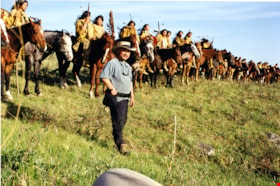
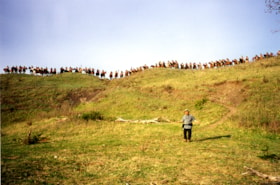
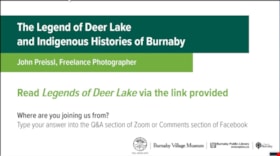
![Mary Stanley and two women with totem pole, [195-] thumbnail](/media/hpo/_Data/_BVM_Images/2022/2022_0032_0669_001.jpg?width=280)
